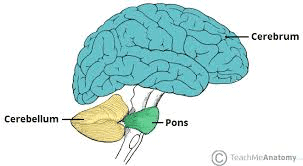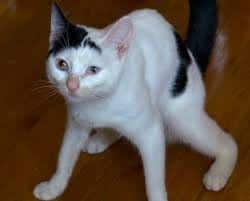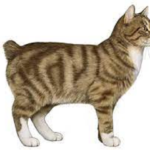Cerebellar hypoplasia (Spastic Cat Syndrome and Wobbly Cat Syndrome)
A kitten born with cerebellar hypoplasia is abnormal from infancy, though it may not be clear that something is wrong until the kittens are becoming more ambulatory. The cat with this disease clearly has balance issues: he/she walks with his legs widely placed to not fall and has clumsy foot placement. Sitting still, he may look like a fairly normal cat but once focused on a toy, food bowl or friendly hand, tremors begin and get more severe as concentration becomes more intense. Still, despite the obvious impairment, cats with this condition are happy, able to feed themselves and use a litter box, and are felt to have good life quality.
Your Cerebellum and You

The cerebellum helps fine tune all our movements. The reason we can maintain balance over all types of surfaces as we walk or reach for things is due to the function of our cerebellum.
The cerebellum is part of the central nervous system though not exactly part of the brain. It is nestled inside your skull at the base of the brain as shown in the picture above. The cerebellum is involved in the involuntary aspects of moving our bodies, whether we are walking, reaching for something, or moving our head.
The cerebellum receives information from the limbs as well as from the eyes and head position. This information tells us what up and down are and where the body needs to move to accommodate itself. When the cerebellum is underdeveloped, these simple functions aren’t properly coordinated between the brain and the body.
The Cat Cerebellum and the Feline Distemper Virus (Panleukopenia)
The cerebellum is a complex part of the nervous system. During fetal development the cerebellum is maturing until just before birth and finishes development soon after birth. The long development period leaves the cerebellum vulnerable to an assortment of toxins and infections for a long period of time.
In the case of cerebellar hypoplasia (incomplete development of the cerebellum) the culprit is feline distemper virus (panleukopenia virus). Following a pregnant cat’s infection, part of the unborn kitten’s cerebellum is destroyed, resulting in a tiny underdevoped cerebellum. To you, this looks like a wobbly cat with some head tremors; the good news is, this is a non-progressing disability for the kitten.
Diagnosis
While imaging such as CT scanning or MRI can be used to confirm the underdeveloped tiny cerebellum, the diagnosis of this condition is usually obvious because of the following symptoms:
- The cat / kitten is poorly coordinated without being weak
- Intention tremors are evident when the cat is focused but he/she largely normal if still
- Walking is uncoordinated with a wide stance

adult cat
Treatment
No treatment can resolve the damage in a kitten with cerebellar hypoplasia. Some kittens are more severely affected than others. Owning a cat with cerebellar hypoplasia emphasizes managing the condition. The cat should be indoors only and non-spill food dishes should be obtained. Most cats have good life quality and make up in personality what they lack in motor skills.
Prevention
This syndrome is prevented by vaccinating female cats for feline distemper when they are neither pregnant nor nursing. This means that regular vaccination will prevent cerebellar hypoplasia in kittens. If a cat is pregnant, vaccination should be withheld during pregnancy and for a good three to four weeks after the kittens are born.


